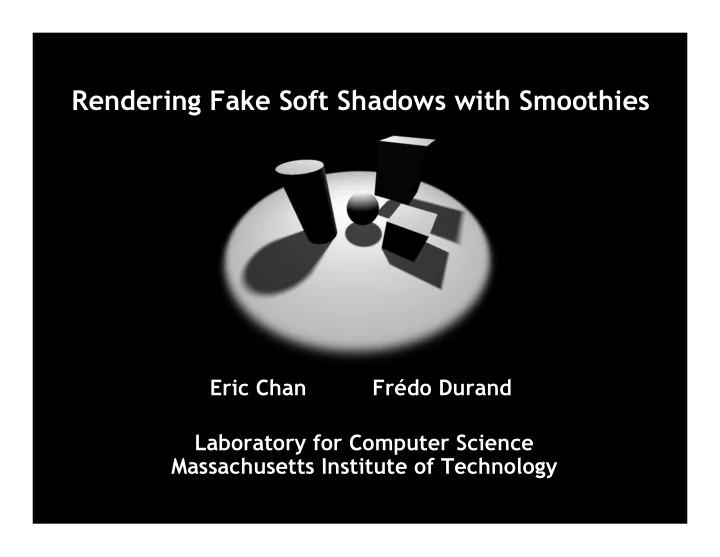

Rendering Fake Soft Shadows with Smoothies Eric Chan Frédo Durand Laboratory for Computer Science Massachusetts Institute of Technology
Real-Time Shadows Goals: Interactive framerates � Hardware-accelerated � Good image quality � Dynamic environments � Applications: NVIDIA Game engines (e.g. Doom 3) � Interactive walkthroughs � Challenge: balancing quality and performance
Two Algorithms from the 1970’s Shadow volumes (Crow 1977) Object-space � Accelerated by hardware � stencil buffer Large fillrate consumption � Shadow maps (Williams 1978) Image-space � Fast and simple � Supported in hardware � Undersampling artifacts � NVIDIA
Soft Shadow Volumes Penumbra wedges: wedge Shadow polygons wedges � Compute penumbra with pixel � shaders Accurate approximation � Papers: Assarsson et al. (EGRW 2002, � SIGGRAPH 2003, HWWS 2003) But: much higher fillrate needed Assarsson and Akenine-Möller
Soft Shadow Maps Ideas: Filtering � Stochastic sampling � Image warping � Agrawala et al. Examples: Percentage closer filtering (Reeves et al., SIGGRAPH 1987) � Deep shadow maps (Lokovic and Veach, SIGGRAPH 2000) � Image-based soft shadows (Agrawala et al., SIGGRAPH 2000) � Multisampling hard shadows (Heckbert and Herf, TR 1997) � But: need dense sampling to minimize artifacts
Soft Shadow Maps (cont.) Approximations Examples: Soler and Sillion Convolution (Soler and Sillion, SIGGRAPH 1998) � Linear lights (Heidrich et al., EGRW 2000) � Outer surfaces (Parker et al., TR 1998) � Plateaus (Haines, JGT 2001) � Penumbra maps (Wyman and Hansen, EGSR 2003) �
Overview Extend basic shadow map approach � Use extra primitives (smoothies) to soften shadows � light’s view (blockers only) light’s view (blockers + smoothies)
Fake Soft Shadows Shadows not geometrically correct � Shadows appear qualitatively like soft shadows � Hard shadows Fake soft shadows
Contributions Smoothie shadow algorithm: Creates soft shadow edges � Hides aliasing artifacts � Efficient (object / image space) � Hardware-accelerated � Supports dynamic scenes �
1. Create Shadow Map Render blockers into depth map observer’s view light’s view
2. Identify Silhouette Edges Find blockers’ silhouette edges in object space object-space silhouettes observer’s view light’s view
3. Construct Smoothies Blocker only: silhouette vertex silhouette edges blocker exterior
3. Construct Smoothies (cont.) Blocker + smoothies: silhouette vertex t silhouette edges t smoothie edge smoothie corner blocker exterior
3. Construct Smoothies (cont.) Smoothie edges are rectangles in screen space with � a fixed width Smoothie corners connect adjacent smoothie edges � t t geometry shading
4. Render Smoothies Store depth and alpha values into smoothie buffer Smoothie Buffer (depth) Smoothie Buffer (alpha) light’s viewpoint
5. Compute Shadows Compute intensity using depth comparisons light source smoothie blocker receiver
5. Compute Shadows Image sample behind blocker (intensity = 0) light source smoothie blocker receiver completely in shadow
5. Compute Shadows Image sample behind smoothie (intensity = α ) light source smoothie blocker receiver partially in shadow
5. Compute Shadows Image sample illuminated (intensity = 1) light source smoothie blocker receiver illuminated
Computing Alpha Values Intuition: Alpha defines penumbra shape � Should vary with ratio b/r � light source smoothie α r b blocker receiver
Computing Alpha Values (cont.) 1. Linearly interpolate alpha 2. Remap alpha at each pixel using ratio b/r: α ’ = α / (1 – b/r) original α remapped α result
Multiple Blockers and Receivers
Multiple Receivers Smoothie buffer (linearly-interpolated α ) 1 same thickness 2 light’s view
Multiple Receivers (cont.) Smoothie buffer (remapped α ) 1 different thickness 2 light’s view
Multiple Receivers (cont.) Final image different thickness observer’s view
Multiple Blockers What happens when smoothies overlap? smoothie overlap
Multiple Blockers (cont.) Minimum blending: just keep minimum of alpha values smoothie ray tracer
Comparison to Penumbra Maps Penumbra maps (Wyman and Hansen, EGSR 2003) Same idea, different details � Penumbra Maps Smoothies Geometry: cones and sheets quads blockers only blockers + smoothies Store depth: Smoothie depth: Extra storage + comparison � Handles surfaces that act only as receivers �
Results System information: 2.6 GHz Intel Pentium 4 � NVIDIA Geforce FX 5800 Ultra �
Video
Hiding Aliasing (256 x 256) 16 ms 129 ms shadow map bicubic filter 19 ms 19 ms smoothie (t = 0.02) smoothie (t = 0.08)
Hiding Aliasing (1024 x 1024) 17 ms 142 ms shadow map bicubic filter 22 ms 24 ms smoothie (t = 0.02) smoothie (t = 0.08)
Comparison to Ray Tracer increasing size of light source smoothie ray tracer
Video original md2shader demo courtesy of Mark Kilgard
Discussion Shadow maps: Assumes directional light or spotlight � Discrete buffer samples � Shadow volumes: Assumes blockers are closed triangle meshes � Silhouettes identified in object space � Smoothies: Rendered from light’s viewpoint � Occupy small screen area inexpensive �
Summary Contribution: Simple extension to shadow maps � Shadows edges are fake, but look like soft shadows � Fast, maps well to graphics hardware �
Trends in Real-Time Shadows Architectures and algorithms go together Currently, architectures algorithms: Store per-pixel data at full precision � But also, algorithms architectures: Shadow maps � Shadow volume depth bounds � Aggressive early z and stencil reject �
Acknowledgments Hardware, drivers, and bug fixes Mark Kilgard, Cass Everitt, David Kirk, Matt Papakipos (NVIDIA) � Michael Doggett, Evan Hart, James Percy (ATI) � Writing and code Sylvain Lefebvre, George Drettakis, Janet Chen, Bill Mark � Xavier Décoret, Henrik Wann Jensen � Funding ASEE NDSEG Fellowship �
Recommend
More recommend